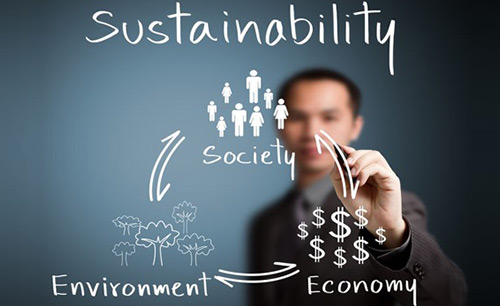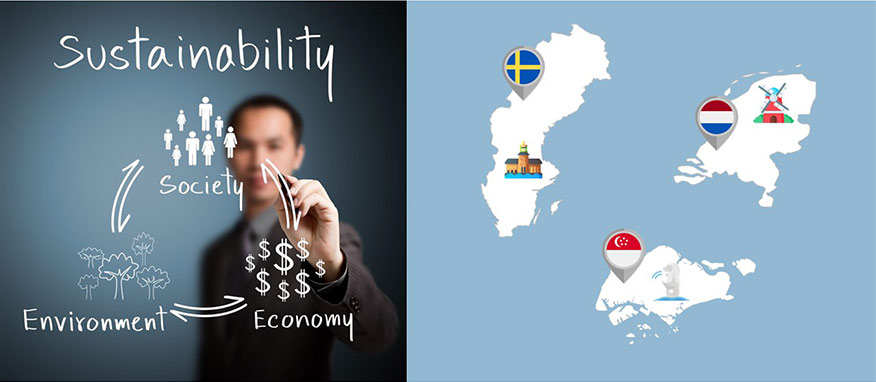
Sustainability as a competitive advantage? Why companies should act now!
In recent years, sustainability has increasingly become a predominant topic in the public debate. But what is sustainability actually? There is no uniform definition, at least in the corporate world. If you ask 10 people, you'll get what feels like 9 different answers. In Germany, we always think very quickly of climate protection and ecological sustainability when the topic comes up. Sustainability has various dimensions. In addition to the ecological approach, there are also the social and economic sustainability perspectives. For companies, the latter are likely to be of particular interest in terms of their own business model and maintaining competitiveness in the future. The majority of companies become active especially when a corresponding pressure to act arises. This can be expressed, for example, by an expectation of turnover, anticipated changes in legislation or reactions to the shortage of skilled workers. The challenges that companies will have to deal with in the future are very different.

Fig.1: The 3 pillars of sustainability
Markets are changing
What started earlier in the consumer segment is also increasingly influencing B2B markets. The demand for sustainable products and services is rising continuously, even if the willingness to pay is still very different. This trend will also not be reversed. The current Corona pandemic briefly pushed the topic into the background, but it has been gaining momentum again for several months. If you look at these developments globally, you will quickly come across countries where sustainability is a national strategy. Sweden, the Netherlands, and Singapore are examples of countries from which we can learn in this context. If companies want to be successful with their products and services in these markets, they must adapt to local conditions. For this reason, some manufacturers have already added sustainable alternatives to their conventional product lines in order to meet both national and international demand in this segment.
Countries we can learn from

Fig.2: Example countries with national sustainability strategies
What do these developments mean for your own company?
Many corporate leaders are confronted with very different problems. In addition to digitization, globalization or innovation, sustainability is currently just another trend for many, which brings with it additional work in the sometimes very stressful day-to-day business. Also, the pressure to act is not yet noticeable everywhere. But when is the right time to integrate the topic into the corporate strategy? This question is not easy to answer and requires individual consideration.

Fig.3: Examples of sustainability goals
The only thing that is clear is that the markets in most industries will change radically and companies should incorporate this development into their strategic considerations at an early stage. In this context, the goals and measures can be very different. While some companies fear risks to their business model, others tend to focus on sales opportunities through sustainable action.
How do I make my company fit for a sustainable future?
In order to draw up a plan for the future direction of the company that is as valid as possible, an internal and external analysis should first be carried out. If we assume that customer preferences, the labor market, the capital market and supply chains (e.g. raw material procurement) or production processes will change significantly in the future, the corporate structures must be adapted accordingly. Based on the analysis, concrete fields of action should be derived to help develop an adequate strategy. The planning horizon should cover at least the next 10-15 years and include expected technological developments. Overall, a sustainable orientation can be understood as an optimization process that should not be limited to ecological sustainability aspects. Rather, it is a 360-degree view that helps to identify future risks and fields of action at an early stage and to be able to react to them. The process also helps to identify opportunities and generate targeted competitive advantages.
Model for the development of a sustainability strategy

Fig.4: Process of strategy development
Bottom line
Sustainability will become one of the major topics of the next decades, which will radically change the economy. However, it is not a matter of converting one's own company completely sustainably from one day to the next just for the sake of it. Rather, the goal should be to identify and define meaningful optimization measures in order to prepare one's own company for change and to keep it competitive in the long term. In the process, competitive advantages can also arise from the optimization measures developed. Companies should not see sustainability as a threat per se, but rather as an opportunity for a necessary optimization process that brings with it many positive aspects.
About DTO - Industry Markets
Due to often high technical complexity and specialized markets, industrial and industrial goods market research differs strongly from market research in the consumer sector. Very often, information such as market volume, market shares, market developments or strategies or business models of competitors for industrial products are not publicly available. One's own research via the Internet (e.g. on websites or via association information) or during discussions at trade fairs, usually quickly reaches its limits here. However, valid information regarding market prices, trends, developments, customer preferences or market shares is essential in order to optimally align one's own company with the sales market.
Further Information
We at DTO are specialized in generating the information you need for your decisions in such markets as well. In doing so, we usually work with expert interviews (competitors, potential customers, associations, distributors, etc.) and can generate an optimal picture for your company by combining different opinions and views.
Text written by Michael Di Figlia